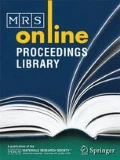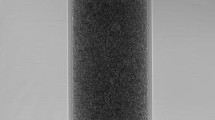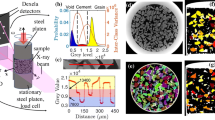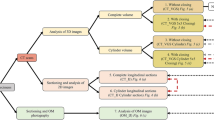Abstract
Digital acquisition and analysis of backscattered electron images provide powerful tools for the study of cement-based materials. The techniques can provide useful information on hydration phases, size distributions of unhydrated particles and voids, effects of changes in the watercementitious material ratio and the use of mineral admixtures, and the distribution of microcracks. The results of automated analyses of cement pastes with different water-cement ratios and pastes containing silica fume are presented. The analyses demonstrate that microstructural data vary significantly from image to image, requiring multiple images to limit the effects of scatter. The analyses also indicate that, although the pastes exhibit different degrees of hydration, the size distributions of the unhydrated cement particles are nearly identical. In contrast, the size distribution of larger voids differs significantly as a function of water-cementitious material ratio and with the use of silica fume as a partial replacement for cement. The calcium hydroxide content obtained based on image analysis exceeds but generally parallels that obtained with thermogravimetric analysis. The majority of microcracks in both nonloaded and loaded specimens occur through or adjacent to the lowest density hydration phase.
Similar content being viewed by others
References
K. L. Scrivener and P. C. Pratt in Proc., 6th Intl. Conf. on Cement Microscopy (Albuquerque, NM, 1984).
K. L. Scrivener and E. M. Gartner in Bonding in Cementitious Composites, edited by S. Mindess and S. P. Shah (Mater. Res. Soc. Proc. 114, Pittsburgh, PA, 1988) pp. 77–85.
K. L. Scrivener in Pore Structure and Permeability of Cementitious Materials, edited by L. R. Roberts and J. P. Skalny (Mater. Res. Soc. Proc. 137, Pittsburgh, PA, 1989) pp. 129–140.
H. Zhao and D. Darwin, Cem. Concr. Res. 22, (4), 695 (1992).
D. Bonen and S. Diamond, Cem. Concr. Res. 22, (6), 1059 (1992).
K. W. Ketcham, F. A. Romero, D. Darwin, S. Gong, M. N. Abou-Zeid, and J. L. Martin, SM Report No. 34, (University of Kansas Center for Res. 1993).
J. I. Goldstein, D. E. Newbury, P. Echlin, D. C. Joy, A. D. Romig, C. Fiori, and E. Lifshin, Scanning Electron Microscopy and X-Ray Microanalysis, 2nd ed. (Plenum Press, New York and London, 1992).
B. Ostle and L. C. Malone, Statistics in Research, 4th ed., (Iowa State University Press, 1988).
D. Darwin, M. N. Abou-Zeid, K. W. Ketcham in Proc., 16th Intl Conf. on Cement Microscopy (Richmond, VA, 1994).
L. Hjorth in Microsilica in Concrete 1, paper 9 (Aalborg Portland, Denmark, 1982).
G. W. Groves, Cem. Concr. Res. 11 (5/6), 713 (1981).
K. H. Khayat and P. C. Aïtcin in Fly Ash, Silica Fume, Slag, and Natural Pozzolans in Concrete (Amer. Concr. Inst., SP-132, II, Detroit, MI, 1993) pp. 835–872.
Author information
Authors and Affiliations
Rights and permissions
About this article
Cite this article
Darwin, D., Abou-Zeid, M.N. Application of Automated Image Analysis to the Study of Cement Paste Microstructure. MRS Online Proceedings Library 370, 3–12 (1994). https://doi.org/10.1557/PROC-370-3
Published:
Issue Date:
DOI: https://doi.org/10.1557/PROC-370-3




